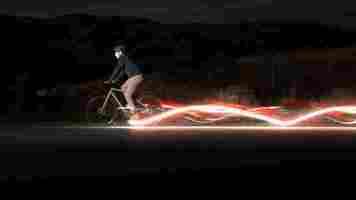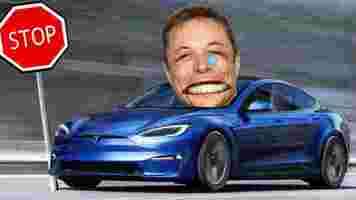Redshift’s LED bike pedals claim to keep cyclists safer than regular lights
Did you know SHIFT is taking the stage this fall ? Together with an amazing line-up of experts, we will explore the future of mobility during TNW Conference 2021. Secure your ticket now!

I’m all about proper lighting on bikes. I was an occasional driver before I started riding my ebike everywhere, so I’m well aware of the dramatic difference a couple of lights can make to keep cyclists safer on the road.
But though I’ve seen lights integrated into ebike frames, helmets, wheels, and more, Redshift‘s new Arclight pedals are one of the few times I’ve seen bike lighting integrated right below your feet. Redshift isn’t the only company to adopt this concept, but the Arclight is definitely the most intriguing take on light-up pedals I’ve seen yet.
Now, first things first: this is a crowdfunding campaign. Those are often subject to delays and disappointment, and we normally don’t even cover them unless we’ve tested a prototype.
In this case, I’m making an exception because Redshift is an established bike accessory company — one which makes my favorite suspension seatpost and stem , both of which launched on Kickstarter as well. I’ll be getting samples within the coming days, and will update this post when I’ve got my hands on them.
The pedals are actually composed of a few separate components each: the aluminum pedal itself, as well as magnetic light modules that insert into the pedal. These are rechargeable via USB, and can be removed to add illumination to other parts of your bike if you’d like.
The Philly-based company claims the design is more than just a futuristic-looking gimmick. It cites a 2020 study that found that highlighting ‘biological motion’ — the more exaggerated movement of your legs, specifically — can improve visibility by “up to 57%” compared to plain old bike headlights and taillights.
In the study, cyclists were asked to place taillights in different locations during daytime rides. It was found that strapping lights to their ankles made them significantly more visible than regular lighting locations. In the second part of the study, it was found that wearing fluorescent leg covers in addition to a fluorescent jersey improved visibility by 3.3x compared to the jersey alone.
Intuitively, that makes some sense to me too. When I’m driving, I don’t always know if a light in my rearview mirror is from a bike, another vehicle, or some other light source altogether. LED pedals would make it pretty obvious the approaching lights are from a bike. It’s just one study, but those results are enough to convince me.
Some other highlights about the Arclight pedals:
The lights provide a 360-degree illumination pattern rather than just a narrow beam in front and behind you.
They come with an auto-on and off feature based on your motion.
The pedals can automatically detect their orientation so you always have a white light facing forwards and red light facing backward.
Battery life is rated at up to ’36+’ hours in the lower power flashing setting, although just 3+ hours with the steady light setting.
The lights have an integrated USB plug — no need to fish around for a tiny cable. There’s also an included charging dock for topping up multiple lights off one outlet.
The lights are IP64 water and dust-resistant.
You can also mount the light modules to your handlebar or seatpost, like regular lights.
There are just a few caveats to keep in mind. The pedals are, unsurprisingly, a little pricey at an MSRP of $135 (going for $109 on Kickstarter) for two pedals, four lights, and the charging dock. But there are regular, non-shiny pedals that sell for that much anyway, let alone once your add in some extra lights. Especially if the safety claims pan out, it could well be worth the extra expense.
It should also be noted that the primary goal here is to help you be seen rather than being able to see ahead of you in a poorly lit road. For that, you’ll still want a decent headlight, although I’m curious to see how the individual light modules perform when I get my hands on them.
Still, the Arclight pedals look like a welcome new option for lighting up your bike — one that’ll hopefully keep cyclists a little safer on the road.
Do EVs excite your electrons? Do ebikes get your wheels spinning? Do self-driving cars get you all charged up?
Then you need the weekly SHIFT newsletter in your life. Click here to sign up.
Tesla’s ‘rolling stop’ feature mimicked dumb humans — and got 54K EVs recalled
Tesla is recalling nearly 54,000 vehicles in the US, as a recent Full Self-Driving (FSD) Beta update allows its cars to perform a “rolling stop.” This means the vehicle doesn’t come to a complete halt at a stop sign , instead moving slowly through it.

Unsurprisingly, the National Highway Traffic Safety Administration (NHTSA) has issued a safety recall of the feature, which it deemed dangerous:
Thanks for that, NHTSA.
According to the NHTSA, Tesla introduced the rolling stop functionality last October through a “limited access” over-the-air update.
As part of this, Tesla owners could choose between different profiles for their car’s self-driving features: Chill, Average, and Assertive.
The Assertive mode was accompanied with a warning that the vehicle “may perform rolling stops.”
The NHTSA’s report specifies the rolling stop feature “allows the vehicle to travel through all-way-stop intersections at up to 5.6 mph before coming to a complete stop” — if certain conditions are met first.
The most important are:
No vehicles, pedestrians, or cyclists are detected near the intersection.
The vehicle has sufficient visibility when approaching the intersection.
The EV maker has decided to voluntarily (not that there was any other option) recall the functionality from the affected 2016-2022 Model S and Model X, 2017-2022 Model 3, and 2020-2022 Model Y vehicles.
This doesn’t mean that owners of these vehicles will have to take any physical action. Tesla will release another over-the-air update that will disable the rolling stop feature, starting in early February.
Naturally, Elon rushed to defend Tesla’s software and — why the hell not? — insult a journalist for “misreporting.”
Indeed, Tesla notified the NHTSA that, as of January 27, 2022, it’s not aware of “any warranty claims, field reports, crashes, injuries or fatalities related to this condition.”
But Musk’s nonchalant justification of the software raises deeper concerns.
During Tesla’s Q4 2021 earnings call , the celebrity CEO predicted that FSD will be safer than human drivers by the end of 2022:
But programming an autonomous software to take the same kinds of shortcuts a human driver does undermines the whole “autonomous cars will be safer” argument.
Especially since we’re still unsure autonomous systems are able to make the judgements a human driver can when it comes to rule bending.
And there’s another issue here: it looks like the feature was designed to break laws. Because, you guessed it, performing a rolling stop in the US is, well, illegal. And it’d get you a nice fat ticket.
So why would Tesla enable a feature that’s technically illegal?
Was it a programming oversight? Does the company believe that “stopping” actually means “slowing down?” Or does it simply think it has enough money to be above the law?
No matter the answer, there’s one thing I know for sure: we’ll never trust an automated vehicle that makes human mistakes — and we don’t need a bunch of rogue Teslas deliberately breaking road laws.
7 reasons why we are failing to decarbonize transport
Transport accounts for 21% of global carbon emissions . It is now the largest emitting sector in many developed countries. While Europe and North America dominate historic transport emissions, much of the projected growth in emissions is in Asia.

Even if current and committed policies were to succeed, transport’s carbon emissions would still grow almost 20% by 2050 . Highly ambitious policies could cut these emissions by 70% – but not to zero.
In honor of “transport day” at the COP26 climate summit, here are seven reasons global transport is particularly hard to decarbonize.
1. Demand is closely linked to population and economic growth
As economies and populations grow, demand for goods grows, as does the number of people with the desire and means to travel. Globally, total transport activity is expected to more than double by 2050 compared with 2015 under the trajectory reflecting current efforts. Any technological advances in decarbonising transport would simply be more than offset by increased demand for mobility. This has led many to believe that there is no way we can meet the decarbonisation targets of the Paris agreement by 2050 without reducing demand to more sustainable levels.
But this is hard to do. It requires the transformation of the whole transport system, including tackling how often and how far we travel and move goods. Some of the more promising options, such as road-space reallocation and higher fossil fuel taxes have met resistance.
2. Transport is still 95% dependent on oil
The (near) total dependence on oil across all forms of passenger and freight transport is hard to change.
Substituting oil with low carbon “fuels”, such as electricity, will drastically reduce emissions by 2050. But even an optimistic scenario where global new car sales were 60% electric by the end of the decade would see CO₂ emissions from cars drop by only 14% by 2030 compared with 2018.
3. We are too obsessed with electric cars
The COP26 presidency programme focuses entirely on road-transport electrification. Yet life-cycle emissions from electric vehicles depend heavily on the kind of electricity, battery and materials used. Globally, uptake has been slow apart from a few leaders, such as Norway, which has thrown everything at the transition – funded by revenues from fossil-fuel exports no less. Even if all new cars were electric from today, it would still take 15-20 years to replace the world’s fossil fuel cars.
Electric cars do not solve problems of road traffic congestion, safety and other issues of car dependency . They also need a reliable electricity supply – not a given in many parts of the world – and do not address transport inequality and social injustice within and between countries, especially in the developing world where e-cars may well only be an option for the powerful and wealthy.
4. ‘Jet zero’ is still a mirage
Middle- to long-distance air travel is hard to decarbonise because realistic “jet zero” technologies are limited for longer distances. Electric plane batteries simply can’t store enough power while remaining light enough. Zero carbon aviation fuels and electric airliners are neither proven nor can be scaled up to the level needed for emissions from flying to fall fast.
However, we should be able to reduce the total number of flights by, for example, introducing frequent-flyer levies . A few frequent flyers cause most emissions: in 2018, 50% of aviation emissions were caused by 1% of the world’s population . About 80% of people in the world have never flown. New research shows that a 2.5% annual decline in flights could significantly limit aviation’s warming effect by 2050. While most people won’t be affected, frequent flyers would have to radically curtail their habit – which may be tough to enforce, as they are more likely to be wealthy and powerful.
5. Cargo ships run on diesel and last for decades
The difficult-to-decarbonise maritime shipping sector was not part of the Paris agreement, and is projected to represent up to 10% of all global emissions by 2050 if left unchecked. Ships last for decades and run largely on the most polluting type of fossil diesel. Electrification is not a viable option.
As with aviation, ships operate in a global market so are difficult to govern and regulate. But the sector has significant potential to reduce emissions through a combination of retrofitting to use zero-carbon fuels, such as green ammonia , and “slow steaming”. A 20% reduction in ship speeds can save about 24% of CO₂ .
6. A collective sense of entitlement to the status quo
A collective sense of entitlement and dislike of limiting “personal choice” have a lot to do with inaction on reducing and improving travel by powered vehicles. Many people are reluctant to give up their car or flying, feeling that it is an infringement of their rights. Efforts to decarbonise transport are being hindered by a cultural attachment to the polluting status quo, which isn’t as present in other sectors.
7. We are locked into bad habits
Many developed countries are firmly locked into high-carbon infrastructures and lifestyles . Most modern cities have been built to serve cars, not people. The necessary roads, parking lots, driveways are set to last decades.
To reverse this needs a shift in how we use our land and transform our cities, both in terms of mitigating climate change and adapting to its effects. This will need investment and political will. Major funding for new road-building programmes should be reallocated to fund high-quality, zero-emission public transport and active travel . That’s the easy part. Political will and leadership in the face of uncertainty and initial resistance to change is harder to find.
This article by Christian Brand , Associate Professor in Transport, Energy & Environment , University of Oxford , is republished from The Conversation under a Creative Commons license. Read the original article .